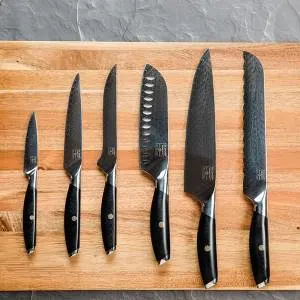 A well-stocked kitchen doesn’t just have pots and pans. There are also knives for cutting, chopping, dicing, mincing, and more. It can be difficult to know which knife is best for the task at hand.
A well-stocked kitchen doesn’t just have pots and pans. There are also knives for cutting, chopping, dicing, mincing, and more. It can be difficult to know which knife is best for the task at hand.
There are many different types of knives that all do different things, so it’s important to have a few in your kitchen arsenal. From paring knives and chef’s knives to bread knives and boning knives, here are 11 varieties of kitchen knives you should consider adding to your collection.
This blog post will teach you all about different types of kitchen knives and how they’re used in the kitchen!
Read More: 15 Essential Vegan Kitchen Tools
Types of Kitchen Knives – an Introduction
The types of knives that every cook needs in their kitchen can vary depending on the types of cuisine they like to make. While one-pot meals are great, sometimes you want a nice cut of meat—which requires several types of specialty knives.
Here we will go over some common types of kitchen knives and the ones we feel are essential in any home chef’s kitchen.
Chef’s Knife
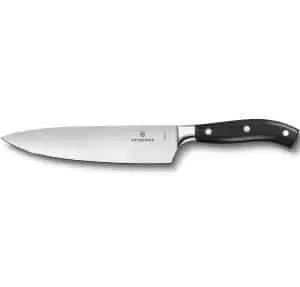 A chef’s knife is a kitchen knife that chefs use. It is a multi-purpose knife and it can be used for chopping, dicing, or slicing just about anything in the kitchen from fruits to meats. Chef’s knives are usually made with stainless steel blades because they have better edge retention than carbon steels types of knives making them not as prone to staining or rusting over time.
A chef’s knife is a kitchen knife that chefs use. It is a multi-purpose knife and it can be used for chopping, dicing, or slicing just about anything in the kitchen from fruits to meats. Chef’s knives are usually made with stainless steel blades because they have better edge retention than carbon steels types of knives making them not as prone to staining or rusting over time.
A chef’s knife will make a great addition to any home cook’s collection of cooking tools since many recipes require their ingredients to be cut into specific shapes prior to being cooked.
A useful feature of the chef’s knife is its handle; it comes in both types (one for left-handers and one for right). It can be used to cut almost anything, including vegetables, meat/fish, fruit, and bread. Its blade keeps sharp well through constant contact with hard surfaces such as cutting boards or granite countertops.
The most common use of this type of kitchen knife is when chopping food into smaller pieces using a rocking motion while holding down what you are cutting on your board.
The Chef’s Knife has many names: French knife, cook’s knife, all-purpose knife. Precisely because there are so many types available it is important to choose the best suited to your culinary habits.
Read More: How To Polish Knife Blade Scratches: 6 Simple Methods
Santoku Knife
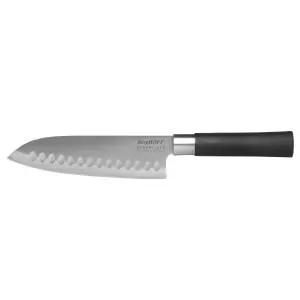 A santoku knife is a Japanese knife that is shorter and thinner, typically six to eight inches, with a straight edge and flat back.
A santoku knife is a Japanese knife that is shorter and thinner, typically six to eight inches, with a straight edge and flat back.
The santoku is often used as an all-purpose knife for dicing, mincing, or chopping vegetables, meat and fish. It works well on both hard surfaces like cutting boards made of wood or plastic composites along with softer materials such as fruits and vegetables; it can even be used against bones (use caution).
The flatter design allows the cook’s hand to rest closer to the blade while making precise cuts that require little effort. A good quality santoku will have a “comfortable grip,” but may also include a non-slip handle if needed in wet conditions.
Read More: How to peel & chop ginger
Utility Knife
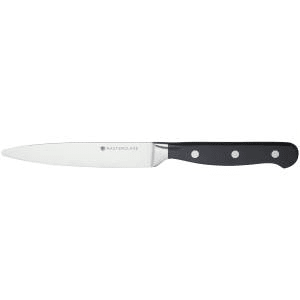 A utility knife is a type of knife that has many types. They are used for different purposes in cooking and can be found in most kitchens.
A utility knife is a type of knife that has many types. They are used for different purposes in cooking and can be found in most kitchens.
Utility knives have long blades so they are able to cut through meat, cheese, or vegetables with ease. The pointed tip makes them useful for cutting small things that a chef’s knife can’t handle. A utility knife is great for sandwiches, cutting up fruits like apples, or anything that needs to be sliced thin such as ham or cheese.
Utility knives are also useful for filleting fish or cutting away any parts that might not be edible.
Although a utility knife is useful for certain types of food preparation, it should never be used to cut bone because the blade may break off. Also, the pointed tip can easily puncture things so they are not meant to go through plastic wrap or even cardboard boxes.
Kitchen Shears
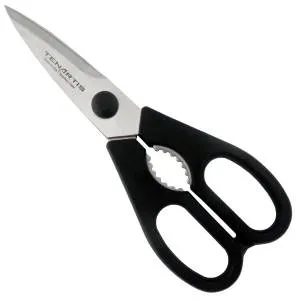 Kitchen shears are not technically a knife, but they are still an important tool in the kitchen.
Kitchen shears are not technically a knife, but they are still an important tool in the kitchen.
Kitchen shears can be used to cut up meat, chop vegetables, and even open packages. A typical pair of kitchen scissors will have one blade that folds into the handle while a hook at the bottom is designed for cutting through tough surfaces.
Kitchen shears are useful for snipping herbs and sectioning chicken.
Kitchen shears can be found for around $20 or less, which makes them a very affordable tool.
There are several types of kitchen shears:
- Stainless steel blades and plastic handles, with a serrated blade to cut tough material like meat and vegetables.
- Plastic handle with stainless steel blades that are not as sharp but will last longer than the first option.
- Heavy-duty kitchen shears made from forged alloyed aluminum for strength and weight control with rust-resistant coating on stainless steel cutting surfaces
Boning Knife
A boning knife is a type of kitchen knife that has a long and narrow blade. This type of knife is typically used to remove the bones from meat or poultry when it is being cut up into small pieces for cooking purposes. The sharp point on the end can also be helpful in separating skin from flesh while doing this tough job.
While this type of knife can have any size, the most common size for a boning knife ranges from 4″ to 7″. The length of the blade is measured from the handle to the tip.
Bread Knife
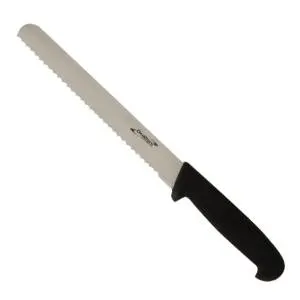 A bread knife is a type of knife that is used to slice bread without squashing it. A bread knife comes with a serrated blade that can slice through soft, tough, or even hard types of bread effortlessly.
A bread knife is a type of knife that is used to slice bread without squashing it. A bread knife comes with a serrated blade that can slice through soft, tough, or even hard types of bread effortlessly.
For home use, a bread knife should be about 12 inches long and have a rounded tip. Professional bread knives are usually longer and also come with a pointed tip.
Like all types of knives, a bread knife can be made from stainless steel or high carbon. A serrated edge is best for cutting bread because it causes less damage to the surface and keeps the texture better than a smooth blade would.
While bread knives are most commonly used in homes to cut up loaves of fresh-baked bread that have just come out of an oven, this type of knife can also be very useful when preparing sandwiches as well since it will not crush them while being squeezed together by two hands.
Bread knives should also never be put into dishwashers because they could cause more harm than good if other items hit against them during washing cycles. An easy way to clean these types of blades is with hot water and dishwashing soap.
A bread knife should be an important tool in any type of kitchen where bread is being made or consumed on a regular basis.
Cleaver Knife
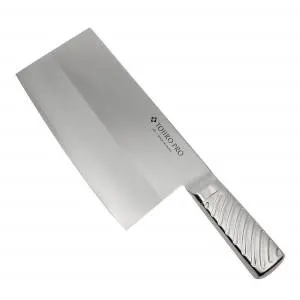 A cleaver knife is a type of kitchen blade that comes with a thick and heavy handle. A typical weight for these types of knives can range from one to four pounds, which allows the user to cut through meats easily because it will not buckle under pressure.
A cleaver knife is a type of kitchen blade that comes with a thick and heavy handle. A typical weight for these types of knives can range from one to four pounds, which allows the user to cut through meats easily because it will not buckle under pressure.
The heavy weight also makes a cleaver knife more efficient than lighter types of blades since there’s less need for force when cutting up tough fruits or vegetables into small pieces while preparing meals in the home or restaurant setting.
Cleaver knives have evolved over time but most modern types come with stainless steel blades and wooden handles so they are easy to clean without worrying about corrosion forming on surfaces after being exposed to moisture during cleaning routines.
Paring Knife
A paring knife is a short, wide-bladed knife that is generally used for peeling and shaping fruits and vegetables. Paring knives can also be used to carve other types of food, such as cheese.
A paring knife is usually around 6-8″ in length with a blade that is 2-3″ long. A good example of the type of knives that are often referred to as “paring” knives are the types of knives that come with hard plastic handles with rubber grips.
According to KitchenKiddo, paring knives are a must-have in any kitchen. As well as being able to be used for paring and peeling, these types of knives can also be used for other tasks such as slicing, chopping, or dicing.
Paring knives come with either serrated blades or plain edges. Serrated edge blades slide easily through the skin of soft fruits and vegetables while still gripping firmly enough that they don’t slip from the user’s hand when “sawing” back and forth on harder foods like apples.
Plain-edged blade types have more cutting ability due to their straight cuts but tend not to grip onto food quite so securely than those with serrations do. This means that smaller jobs may need two hands: one holding the fruit/vegetable in place while the other guides the knife.
Steak Knife
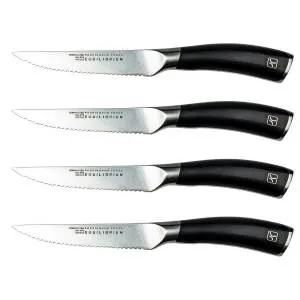 A steak knife is a long, pointed piece of kitchenware that is used for cutting steak, prime rib, or other types of meat. The blade usually has no sharp edges and is serrated to cut the meat more easily.
A steak knife is a long, pointed piece of kitchenware that is used for cutting steak, prime rib, or other types of meat. The blade usually has no sharp edges and is serrated to cut the meat more easily.
This type of knife is also sometimes referred to as a table or slicing knife.
This knife can be used for other types of meat and vegetables, but it was designed specifically with steak in mind. A sharp blade helps cut through the thick pieces while the serrated edge prevents tearing and ripping that would result from using an ordinary kitchen knife on these types of food items.
Steak knives are generally not recommended for use on bread or pastries unless they have some kind of filling inside because this part of its design makes cutting soft surfaces more difficult than harder foods like meats.
Higher-end models will often feature ergonomic handles made out of polypropylene plastic which prevents slippage when wet or greasy hands grip them tightly during meals.
A steak knife is usually about 20-24 cm in length. The blade should have a sharp edge that has no serrations. The perfect size for this knife would be 10 cm, which is the length of the average person’s hand.
Nakiri Bocho Knife
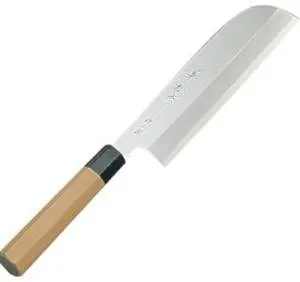 The type of knife is a Japanese-style slicing knife that is popular among home cooks. The Nakiri bocho knife is primarily used for cutting vegetables, and some types of fish. Nakiri bocho knives are typically between five and seven inches in length.
The type of knife is a Japanese-style slicing knife that is popular among home cooks. The Nakiri bocho knife is primarily used for cutting vegetables, and some types of fish. Nakiri bocho knives are typically between five and seven inches in length.
The blade does not have a point. It has an angle of about 30 degrees at the tip and is very thin, some types are only two millimeters in thickness. The blades can be made from carbon or stainless steel alloys, but some types use a mixture of both types of material.
It is important to keep the knife sharp because otherwise, it will chip easily on hard objects like bones or woody vegetables such as squash or celery root. A Nakiri bocho knife should typically be kept dry after every wash so that water doesn’t get trapped between its crevices where rusting may occur if left wet for too long. Be sure to dry off any excess moisture with a towel before storing away your kitchen knives.
Fillet Knife
 A fillet knife is a long, narrow blade that is ideal for the preparation of fish and meat. They range in length from 6 to 20 inches. Fillet knives are typically single-edge blades with a straight or curved cutting edge on the upper side of the blade.
A fillet knife is a long, narrow blade that is ideal for the preparation of fish and meat. They range in length from 6 to 20 inches. Fillet knives are typically single-edge blades with a straight or curved cutting edge on the upper side of the blade.
Fillet knives are necessary for most types of kitchens because they allow cooks to prepare meats and fish easily. A fillet knife can also be used to cut garnishes, specifically salad greens like basil leaves for example, which makes them very versatile. They can also be used to carve types of meats like turkey, beef, and ham.
Fillet knives are typically easy to handle because they often come with rubberized grips that make them comfortable for chefs to use when preparing food in the kitchen.
Many cooks prefer fillet knives over other types of blades because this style is known for being very sharp and durable making it easier to cut through foods without crushing them too much. The flexibility found within these types of blade designs allows users more control over how thin or thick slices can be made depending on what types of dishes need preparation.
Types of Kitchen Knives – Final Thoughts
With so many different knives to choose from, which ones should you invest in? We’ve compiled a list of 11 common types and what we feel are essential knives for any home chef.
This list of essential kitchen knives is not exhaustive, but it’s a great place to start. Whether you need a chef’s knife for slicing vegetables or an all-purpose utility blade for cutting through raw meat, the kitchen knives on this list will help you get the job done.
We hope this post helped make your decision easier when selecting which blades will fit into your unique cooking style best.
